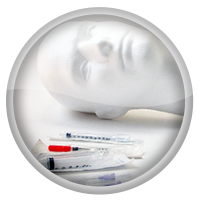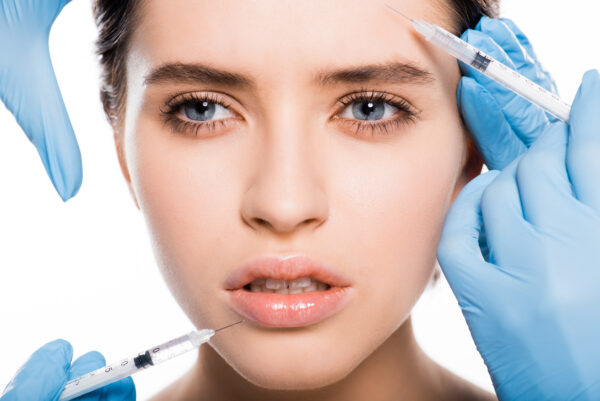Botox Injection Training – Live Online & Interactive

Skip To Training Course Details >>

You want to increase your clientele, but your resources are limited, your time especially so. Adding new services in order to acquire new patients usually involves a significant investment in equipment and training. We understand and we want to help. This year, according to Google, more than 246,000 searches are done for information on Botox every month. Botox typically isn’t covered by insurance, so individuals seeking Botox Injections have the disposable income to pay for it. No anti-aging treatment offers results as quickly or as long lasting as Botox. This is why Botox is the most widely sought after anti-aging treatment in the United States.
 Our Botox training doesn’t stop at teaching you how to administer Botox injection, we also teach you how to explain the benefits of treatment to your prospective patient and how to turn your patients into huge fans that will recommend you to everyone they know.New injectable products are being approved all the time, and injectable products are consistently being approved for new uses. This is why is it so important to make certain you find a course that teaches the most current FDA approved as well as off-label treatments for both aesthetic and therapeutic uses and how they should be used with dermal fillers. Many Botox injection training courses will get you qualified, but our course will offer you added credibility. Course director Dr. Howard Katz is named on the patents for all current Botulinum toxin products. The course is offered online, but on successful completion, you will receive a certificate of completion from Dr. Katz himself.
Our Botox training doesn’t stop at teaching you how to administer Botox injection, we also teach you how to explain the benefits of treatment to your prospective patient and how to turn your patients into huge fans that will recommend you to everyone they know.New injectable products are being approved all the time, and injectable products are consistently being approved for new uses. This is why is it so important to make certain you find a course that teaches the most current FDA approved as well as off-label treatments for both aesthetic and therapeutic uses and how they should be used with dermal fillers. Many Botox injection training courses will get you qualified, but our course will offer you added credibility. Course director Dr. Howard Katz is named on the patents for all current Botulinum toxin products. The course is offered online, but on successful completion, you will receive a certificate of completion from Dr. Katz himself.
 You’re probably wondering how in the world you can learn to administer Botox injection over the internet. Prior to the course, you will receive a kit that includes a foam head along with all of the needles and syringes needed. Throughout the course, the instructor will demonstrate each treatment, showing the placement, angle and depth from multiple angles. You will inject the foam head in the same manner and submit photos of each. We will assess the location, angle, depth and dose of each and either verify the accuracy of your technique or coach you on how to improve. Once you have correctly demonstrated accurate technique for all treatments, we will send your certificate.
You’re probably wondering how in the world you can learn to administer Botox injection over the internet. Prior to the course, you will receive a kit that includes a foam head along with all of the needles and syringes needed. Throughout the course, the instructor will demonstrate each treatment, showing the placement, angle and depth from multiple angles. You will inject the foam head in the same manner and submit photos of each. We will assess the location, angle, depth and dose of each and either verify the accuracy of your technique or coach you on how to improve. Once you have correctly demonstrated accurate technique for all treatments, we will send your certificate.
 During the course, you will watch the class in high definition from a computer, tablet or smartphone and you’ll be able to talk to the instructor just as you would if you were right there in the classroom. You don’t have to be a computer expert to attend. If you can send an email or surf the internet, you’ll have no trouble. When you sign up, you’ll receive an email with a link to the class. As you watch the class, type any questions you may have into the chat box. Use the camera on your computer, or any other digital camera to take pictures of your technique and upload them.
During the course, you will watch the class in high definition from a computer, tablet or smartphone and you’ll be able to talk to the instructor just as you would if you were right there in the classroom. You don’t have to be a computer expert to attend. If you can send an email or surf the internet, you’ll have no trouble. When you sign up, you’ll receive an email with a link to the class. As you watch the class, type any questions you may have into the chat box. Use the camera on your computer, or any other digital camera to take pictures of your technique and upload them.
Maybe you’re still skeptical. One notable advantage to taking a course online is that you still have access to all of the recorded lectures and other course material anytime, day or night. Missed something? Still not quite clear on something? Just got lost at some point and don’t feel as comfortable as you’d like with the procedure? Not a problem. Go back and rewatch the class as much as you want whenever you want. Of course, there’s also the fact that you don’t have travel costs or time away from the office and online Botox injection training becomes rather attractive.
Need more reasons to consider our Botox Injection Training course?

- You can ask questions of Dr. Katz after the class is over, or consult with him on treatment plans for specific patients. Send photos of the patient and he will respond within 24 hours.
- If you live near San Diego or plan on visiting you may attend semi-private hands on classes anytime, for free.
- Get a discount on any of our live patient Dentox programs.
- Receive priority access to all new courses and webinars.
- Receive AGD continuing education credit. Many Botox injection training courses do not offer this.
This course is intended for doctors, nurses and other healthcare professionals. State laws vary as to what specific professions are allowed to administer Botox. Be sure you will be eligible to administer Botox before signing up. Along with online Botox injection training, we also offer local in-person classes. If you have taken the online course, the cost will be deducted from the live class. We also offer private consultation in our office.
When you sign up for Botox injection training, you’ll not only receive the foam head, syringes and needles, you’ll also receive detailed information on pricing on all of the various Botox products and alternative products such as Juvederm and Restylane and when these products are preferable to Botox. You’ll also receive information on how to earn the kind of loyalty from your clients that has them raving about you. It’s our goal that you not only gain proficiency with with products, but that you are also able to develop a loyal following. You will also receive manuals, a list of resources and sample forms.

Treatment with Botox takes only a few minutes and requires no recovery time, many patients stop in for it over their lunch hour. Results are apparent in three to ten days and last three to four months, longer with repeated use. Botox injection is safe and carries few side effects, which are typically mild and temporary.
Our goal is to provide comprehensive training that you can easily integrate seamlessly into your existing practice. By the time you finish the course, you will know:
- The history of Botox as well as how to prepare it and how it works
- When to use Botox and when to use dermal fillers
- Indications and contraindications of Botox
- Facial anatomy and physiology, particularly in terms of aesthetics
- Differences between the various products and how to use them in various circumstances
- Different types of dermal fillers
- Proper techniques for every use of Botox
- How to conduct patient consultations
Course participants gain both extensive knowledge of aesthetic practice, and continued education credit.

Why not revitalize your practice with new, affluent patients?
The Dual Functionality of Injectable Dermal Fillers: A Comprehensive Examination of Lift and Volume Restoration


Injectable dermal fillers offer a non-invasive solution for aging, revolutionizing aesthetic medicine and providing patients with effective treatments.
Injectable dermal fillers have revolutionized the field of aesthetic medicine, offering patients a non-invasive solution to combat the signs of aging. While their primary function is often associated with filling lines and wrinkles, recent advancements and clinical observations have shed light on their additional capacity to provide lift. This article delves into the dual functionality of injectable dermal fillers, exploring their role not only in volumizing but also in lifting facial structures to restore a youthful appearance.
Understanding Dermal Aging
Before delving into the mechanics of injectable dermal fillers, it is crucial to comprehend the anatomical changes that occur during the aging process. As individuals age, various factors, such as collagen depletion, elastin degradation, and bone resorption, contribute to facial volume loss and structural changes. These alterations manifest as sagging skin, hollowed cheeks, and deepening folds, culminating in an aged and tired appearance.
The Role of Dermal Fillers in Volume Restoration
Traditionally, dermal fillers have been primarily utilized to restore lost volume in areas prone to aging, such as the cheeks, nasolabial folds, and lips. These fillers are made of biocompatible materials like hyaluronic acid, calcium hydroxyapatite, or poly-L-lactic acid. They are injected strategically into specific areas to restore lost volume and make the face look younger. By restoring volume, dermal fillers effectively mitigate the appearance of wrinkles and creases, imparting a smoother and more youthful visage.
The Emergence of Lift: A Paradigm Shift in Aesthetic Enhancement
While the volumizing properties of dermal fillers are well-established, recent advancements in injection techniques and product formulations have unveiled their remarkable ability to lift sagging facial tissues. Unlike traditional fillers that merely add volume, newer generations of fillers possess unique rheological properties that enable them to provide structural support and lift. By strategically placing filler along specific vectors and anatomical planes, skilled injectors can subtly elevate drooping features, resulting in a refreshed and rejuvenated look.
Mechanisms of Lift
The lifting effect of dermal fillers can be attributed to multiple mechanisms inherent to their composition and placement. Firstly, certain fillers possess a high degree of viscosity and cohesivity, allowing them to resist gravitational forces and provide sustained support to weakened tissues. Secondly, the strategic placement of filler in areas such as the midface, temples, and jawline can restore lost volume and create a lifting effect through tissue repositioning. Additionally, bio-stimulatory fillers stimulate collagen production, further enhancing tissue elasticity and firmness over time.
Clinical Evidence Supporting Lift
Clinical studies and observational data have corroborated the lifting capabilities of injectable dermal fillers across various facial regions. For instance, volumizing the cheeks with fillers not only restores midface volume but also indirectly lifts the lower face by counteracting gravitational descent. Similarly, injecting fillers along the jawline can redefine the mandibular contour and provide a subtle yet noticeable lift to the jowls. Moreover, strategic filler placement in the temple region can elevate the brow and improve upper facial harmony.
Patient Selection and Customized Treatment Plans
Achieving an optimal lift with injectable dermal fillers necessitates a thorough understanding of facial anatomy, patient goals, and aesthetic ideals. During the consultation process, practitioners assess the degree of volume loss, tissue laxity, and structural integrity to formulate a personalized treatment plan. By tailoring filler selection, injection techniques, and treatment intervals to each patient’s unique needs, medical practitioners can maximize lift while ensuring natural-looking results.
Combination Approaches for Comprehensive Rejuvenation
While dermal fillers excel at addressing volume loss and providing lift, comprehensive facial rejuvenation often entails a multi-modal approach. Combining fillers with neuromodulators such as botulinum toxin can synergistically enhance results by targeting dynamic wrinkles and preventing muscle-induced sagging. Furthermore, adjunctive therapies such as skin tightening procedures and collagen stimulators can complement filler treatments to optimize skin texture and elasticity.
Conclusion
Injectable dermal fillers represent a versatile tool in the armamentarium of aesthetic medicine, offering not only volumizing properties but also remarkable lifting capabilities. By strategically placing fillers along key facial vectors, practitioners can effectively restore lost volume and elevate sagging tissues, yielding natural-looking and harmonious results. As the field continues to evolve, further research and innovation promise to refine techniques and expand the therapeutic potential of injectable fillers in facial rejuvenation.
For those fascinated by the diverse possibilities offered by dermal fillers, a crucial initial step involves consulting with experienced professionals. Through careful assessment of individual needs and goals, these specialists can steer individuals towards a personalized and transformative journey in the realm of cosmetic enhancement. As advancements in the field persist, dermal fillers serve as a testament to the fusion of medical science and artistic precision, providing innovative solutions that challenge conventional norms in cosmetic procedures.
Dentox presents a comprehensive online platform for individuals keen on delving into the realm of dermal fillers. The website, accessible at https://dentox.com/all-courses/dermal-fillers/, features courses designed to keep medical practitioners abreast of the latest industry advancements while positioning them as authorities in dermal filler techniques. Moreover, Dentox offers live courses at https://dentox.com/live-courses/, where participants have the opportunity to engage with real patients, gaining hands-on experience and valuable insights into the application of dermal filler techniques. This commitment to education transcends theoretical knowledge, placing significant emphasis on the practical aspects of administering dermal fillers. By integrating online resources with live classes, Dentox caters to diverse learning preferences, ensuring accessibility for medical professionals globally.
Exploring Diagnostic Botox Injections for Migraine Management


Migraine is a neurological condition with recurring headaches and symptoms, posing major challenges for patients and healthcare providers.
Migraine is a neurological condition characterized by recurrent headaches and associated symptoms, presenting significant challenges for both patients and healthcare providers. While extensive research has been conducted, the precise triggers and underlying mechanisms of migraines remain incompletely understood. Identifying trigger sites within the body is crucial for developing effective treatment strategies and alleviating migraine symptoms. In recent years, targeted diagnostic Botox injections have emerged as a promising approach to pinpointing these trigger sites and guiding personalized therapeutic interventions.
Migraine trigger sites refer to specific anatomical locations that, when stimulated, can precipitate migraine attacks. These sites vary among individuals and may include muscles, nerves, blood vessels, and other structures implicated in migraine pathogenesis. Common trigger sites include the temples, forehead, neck, and shoulders, where muscle tension often contributes to headache onset. Additionally, trigger points within the craniofacial and cervical regions, such as the temporomandibular joint (TMJ) and occipital nerve, play significant roles in migraine initiation. Identifying and targeting these trigger sites is essential for effectively managing migraine symptoms and preventing future attacks.
Botox, derived from botulinum toxin type A, possesses therapeutic properties beyond its cosmetic applications. When injected into specific muscles or tissues, Botox blocks the release of acetylcholine, a neurotransmitter involved in muscle contraction, thereby inducing muscle relaxation and alleviating associated symptoms. Targeted diagnostic Botox injections serve a dual purpose in migraine management: providing therapeutic relief and identifying trigger sites responsible for headache initiation. By injecting small amounts of Botox into suspected trigger points, healthcare providers can observe patient responses and determine whether injected sites correlate with symptom improvement.
Research has shown that diagnostic Botox injections can effectively pinpoint the exact locations of migraine triggers. When patients get Botox injections for migraines, they usually see a marked decrease in the frequency, severity, and length of their headaches. An article in the medical journal highlighted the diagnostic value of Botox injections in identifying the precise locations of migraine triggers. There were significant decreases in the severity and frequency of migraines in patients who showed a 50% or more improvement in Migraine Headache Index scores after injection. Analyzing the sensitivity of Botox injections as a diagnostic technique for migraines yielded 56.7% sensitivity and 80.0% specificity, with a high positive predictive value of 89.5%.
Integrating diagnostic Botox injections into clinical practice requires careful patient selection, precise injection techniques, and diligent treatment monitoring. Healthcare providers should identify patients with refractory migraines or treatment-resistant symptoms who may benefit from targeted injection therapy. Before administering Botox injections, a comprehensive evaluation of the patient’s medical history and migraine symptoms is essential. During the injection procedure, precise anatomical localization of trigger points ensures accurate placement of Botox. Patients should be counseled regarding potential risks and benefits, and close monitoring of treatment responses is essential for assessing the effectiveness and identifying adverse reactions.
Targeted diagnostic Botox injections offer promising implications for optimizing migraine management. By accurately identifying trigger sites, healthcare providers can tailor treatment approaches to address the underlying pathophysiology of migraines. Targeted injection therapy provides a personalized approach, minimizing reliance on systemic medications and reducing the risk of adverse effects. Moreover, diagnostic information obtained from Botox injections informs subsequent treatment decisions, such as selecting preventive medications or complementary therapies. Patients showing positive responses to diagnostic Botox injections may benefit from ongoing therapeutic treatments targeting identified trigger sites, thereby providing sustained relief and improving overall quality of life.
In conclusion, targeted diagnostic Botox injections play a pivotal role in identifying and localizing trigger sites for migraines. By combining therapeutic relief with diagnostic insights, Botox injections offer valuable opportunities for personalized migraine management. Integrating targeted injection therapy into migraine management protocols enables healthcare providers to deliver optimized care, ultimately enhancing treatment outcomes and patient quality of life.
For safe and effective Botox injections, ensure you seek out a certified medical professional. When administered properly, Botox can alleviate the discomfort of chronic migraines and enhance overall well-being. Dentox provides an extensive training program to educate medical professionals on the safe and effective administration of Botox injections. If you’re interested in virtual Botox training, go to https://dentox.com/all-courses/botox-training. Visit https://dentox.com/live-courses/ to gain hands-on experience and training with actual patients.
Exploring the Pros and Cons of ‘Baby Botox’ at 21


In recent years, ‘Baby Botox’ has attracted younger groups, even 21-year-olds.
In recent times, the allure of ‘Baby Botox’ has captured the attention of younger demographics, sparking contemplation among those as young as 21. This trend, propelled by social media influencers and celebrities flaunting ageless skin, prompts reflection on the safety, efficacy, and long-term implications of such cosmetic procedures. This article navigates the discourse surrounding ‘Baby Botox’ and assesses its suitability for individuals at the age of 21.
Understanding Botox: Mechanism and Functionality
Before delving into ‘Baby Botox,’ comprehending the essence and modus operandi of Botox is imperative. Botox, derived from Botulinum toxin, is a neurotoxic protein produced by Clostridium botulinum bacteria. Administered in minute doses, Botox temporarily immobilizes or weakens muscles, thereby mitigating the appearance of wrinkles and fine lines. It primarily targets dynamic wrinkles induced by repetitive facial movements like smiling, frowning, or squinting.
Deciphering ‘Baby Botox’
‘Baby Botox’ epitomizes a cautious approach to Botox injections, employing smaller doses to achieve subtle, natural-looking results. Unlike conventional Botox procedures that might render muscles completely inert, ‘Baby Botox’ aims to preserve facial expressiveness while minimizing wrinkles. This approach resonates particularly with younger individuals seeking preventive measures against aging or desiring nuanced aesthetic enhancements.
The Controversy Encompassing Botox for Young Adults
The notion of embracing Botox injections at 21 elicits skepticism and spurs debates across medical circles and society. Critics posit that engaging in cosmetic procedures at such a tender age perpetuates unrealistic beauty ideals and exacerbates body image insecurities. Furthermore, concerns loom over potential long-term ramifications, such as developing tolerance or resistance to Botox over time.
Conversely, advocates of ‘Baby Botox’ argue that early intervention with minimally invasive techniques can deter the formation of deep-seated wrinkles, preserving youthful skin for an extended duration. They contend that adopting preventive measures during one’s twenties can yield substantial dividends in terms of long-term skin health and aesthetics. Additionally, they advocate for responsible Botox usage under the supervision of qualified medical practitioners as a legitimate option for bolstering confidence and self-esteem.
Considerations for Young Adults Contemplating Botox
For young adults deliberating ‘Baby Botox’ or any cosmetic intervention, a judicious assessment of potential benefits versus risks is imperative. Here are some pivotal factors to consider:
- Consultation with a Qualified Professional: Prioritize consultations with board-certified dermatologists or plastic surgeons to assess individual needs and garner personalized recommendations.
- Realistic Expectations: Maintain pragmatic expectations regarding Botox outcomes, understanding that it necessitates maintenance injections and aims for subtle enhancements rather than drastic transformations.
- Potential Risks and Side Effects: Acknowledge inherent risks like bruising, swelling, or muscle weakness and engage in comprehensive discussions with healthcare providers to comprehend and mitigate such risks.
- Long-Term Considerations: While Botox is generally deemed safe, limited research on its long-term effects warrants prudence. Reflect on potential implications, like tolerance buildup, and explore alternative skincare measures.
- Exploring Alternative Options: Before committing to Botox, explore alternative skincare strategies such as comprehensive regimens, sun protection, and non-invasive treatments.
Conclusion
The decision to pursue ‘Baby Botox’ or any cosmetic procedure at 21 hinges on individual discretion, informed consent, and guidance from proficient medical experts. While Botox offers promise for diminishing wrinkles and preserving youthful skin, a balanced evaluation of its pros and cons is indispensable. Ultimately, the choice to embrace ‘Baby Botox’ underscores personal preferences, informed decisions, and a commitment to responsible self-care.
For medical professionals seeking mastery in safe and efficacious Botox administration, Dentox offers comprehensive training programs. Choose from in-person sessions at various nationwide locations or convenient online modules tailored to your pace. Visit https://dentox.com/live-courses and https://dentox.com/all-courses/botox-training for detailed insights into our live and virtual training offerings.
The Influence of Botox on Professional Success: Exploring Workplace Perceptions


A lot of people are getting Botox because they believe it will do wonders for their professional appearance and career.
In the world of professional appearances, things change slowly. Botox is the latest trend making its way into workplaces. It used to be something only famous people in Hollywood did, but now it’s everywhere. People are choosing Botox because they think it can make them look better and help them succeed at work. This article explores how Botox affects how people are seen at work, looking at what society expects, how social media influences us, and how we present ourselves.
The Rise in Aesthetic Procedures at Work
In recent years, more and more professionals have been getting cosmetic treatments. It seems like the way we think about work and how we look is changing. People are choosing treatments like Botox, laser hair removal, and chemical peels because they’re easy, affordable, and don’t require much time off. Botox is especially popular because it can make you look better, prevent wrinkles without surgery, and work quickly.
Perspectives on Youthfulness and Ability
Studies indicate that in professional environments, older faces might create unfavorable impressions, such as being perceived as less healthy, cognitively sharp, and socially welcoming. The “halo effect,” a mental shortcut where people make decisions based on certain physical characteristics, frequently drives this tendency. People who appear well-groomed usually evoke positive assumptions about their competence, reliability, and skills. Conversely, individuals with older-looking faces may encounter biases regarding their level of ambition and dedication to achieving success. Although these judgments may not always be accurate, they play a role in the growing adoption of non-surgical enhancements in professional settings.
Self-Presentation and Social Media’s Impact
Social media plays a significant role in influencing professional self-presentation and shaping beauty standards and lifestyle trends. Influencers with youthful appearances often promote products aimed at combating signs of aging, positioning Botox as a viable solution. Many of the skincare products advertised on social media tout preventative measures against aging, but few offer quick, tangible results like Botox. With its ability to rejuvenate the skin, smooth wrinkles, and reduce oil production, Botox appeals to those seeking a youthful aesthetic. The resulting perceptions of energy and enthusiasm can positively impact career opportunities and professional networking.
Social Expectations and Gender Inequality
While professionalism encompasses a range of aspects regardless of gender, differences in appearance, especially regarding aging, are apparent. Older men are frequently perceived as seasoned and competent, while aging women encounter expectations to sustain a youthful and appealing look. As women in the workforce grow older, they may encounter remarks about their appearance, prompting many to feel compelled to take action. Non-invasive treatments like Botox provide swift and straightforward options for women aiming to conform to workplace standards and improve their career opportunities.
Alternatives and Professional Advice
Meeting workplace standards involves professionalism and dedication to personal appearance. While Botox and similar treatments provide rapid solutions, adopting basic skincare routines and non-invasive procedures can also enhance one’s overall look. Nevertheless, achieving success in the professional sphere demands more than just physical appearance; it necessitates commitment, a solid work ethic, and ongoing dedication. Individuals should prioritize comprehensive career growth to optimize their chances for progress, understanding that professional competence goes beyond mere physical appearance.
Conclusion
Many older workers aspire to look vibrant and youthful. People feel tremendous pressure from their workplace culture. Their appearance is just as important as their performance on the job. Others resort to aesthetic treatments, such as Botox, to remain competitive, while others just accept the norm and let opportunities pass them by. The procedure takes very little time and is quite inexpensive. It is the responsibility of professionals to initiate a conversation regarding workplace aesthetic requirements. The only way to make the space more welcoming and diverse is to discuss current issues.
Experience the rejuvenating effects of Botox treatment, which can help diminish fine lines, wrinkles, and other signs of aging while enhancing your skin’s suppleness and radiance. With the proper preparation and post-treatment care provided by a trusted practitioner, you can achieve optimal results. Connect with a qualified Botox injector today to explore your treatment options in-depth and schedule an appointment.
For medical professionals seeking to master the art of safe and effective Botox administration, Dentox offers comprehensive training programs. Choose from in-person classes at various locations nationwide or convenient online learning options that allow you to study at your own pace. Visit https://dentox.com/live-courses and https://dentox.com/all-courses/botox-training for detailed information on our live and virtual courses, respectively.
Deciding on Botox Integration in Dental Practice: Advantages and Considerations


Dental offices can provide a wider range of high-quality services when they incorporate Botox treatments.
In the dynamic landscape of dental practice management, owners continuously seek avenues to augment services and establish competitive differentiation. A contemporary approach gaining momentum is the integration of Botox treatments. Initially renowned for its cosmetic indications, Botox demonstrates therapeutic efficacy that aligns closely with modern dental care objectives. Nevertheless, the assimilation of Botox into dental practice entails navigating complexities while capitalizing on its manifold benefits.
Enhanced Comprehensive Care
Dentists, with their intricate understanding of facial anatomy, are uniquely positioned to administer Botox treatments. Beyond its cosmetic applications, Botox exhibits effectiveness in managing medical conditions such as temporomandibular joint disorders (TMJ), bruxism, and migraines—ailments frequently encountered in dental patients. The provision of these services elevates the practice’s standard of care, fostering a holistic treatment paradigm.
Amplified Patient Satisfaction
Incorporating Botox into the practice significantly enhances patient contentment. This integration streamlines care delivery, affording patients the convenience of receiving both dental and Botox interventions in a familiar environment. For patients contemplating Botox, the assurance of receiving treatment from their trusted dentist assuages apprehensions. Moreover, therapeutic Botox for pain management can markedly enhance patients’ quality of life, fostering enduring patient-dentist relationships.
Enhanced Aesthetic Outcomes
In the realm of cosmetic dentistry, the focus transcends teeth to encompass the overall facial aesthetic. Botox serves as a pivotal adjunct in refining smile aesthetics by selectively relaxing facial musculature, potentially augmenting the outcomes of procedures like veneers or teeth whitening. This synergistic approach ensures harmonious results and heightened patient satisfaction.
Attraction of New Patient Demographics
Offering Botox services has the potential to attract diverse patient demographics to the practice. Promoting these services not only retains existing patients with expanded service offerings but also entices new ones who may not have considered dental offices for Botox treatments. This diversification broadens the patient base and amplifies practice visibility within the community.
Augmented Revenue Streams
Strategic integration of Botox fortifies revenue streams with nominal overhead costs. Botox procedures are typically swift and yield substantial returns relative to the invested time and resources. Consequently, they serve as a lucrative addition to dental practices seeking to enhance profitability while ensuring exceptional patient care.
Facilitation of Professional Advancement
Embracing Botox treatments engenders ongoing professional development, facilitating alignment with the latest advancements in dental care. Pursuing training and certification in Botox expands the dentist’s skill set, positioning them as pioneers in the field. This commitment to innovation underscores dedication to patient well-being and distinguishes the practice as a progressive entity.
Challenges to Contemplate
Despite the manifold benefits, integrating Botox services poses challenges. These may encompass navigating certification prerequisites, adherence to state regulations, managing patient expectations regarding non-dental outcomes, and securing appropriate insurance coverage. However, meticulous planning and a proactive stance enable effective surmounting of these hurdles, facilitating seamless integration.
Final Considerations
The addition of Botox treatments enriches the scope and quality of services rendered by dental practices. This expansion not only benefits patients by streamlining care delivery but also propels practice growth and enhances reputation. While challenges abound, the potential rewards render Botox a valuable addition to forward-thinking dental practices committed to expanding offerings and elevating patient care standards.
When deliberating Botox treatment, selecting a provider esteemed for expertise and excellence in cosmetic procedures is paramount. Competent healthcare professionals possess the requisite proficiency to administer Botox injections safely and adeptly. Before embarking on treatment, diligent research on potential providers, scrutiny of reviews, and comprehensive consultations to delineate treatment objectives and expectations are imperative.
Dentox offers a comprehensive training regimen meticulously tailored to educate healthcare professionals on optimal Botox injection protocols and techniques. Their exhaustive online and in-person training modules, accessible at https://dentox.com/all-courses/botox-training/ and https://dentox.com/live-courses/, empower healthcare providers to optimize patient outcomes and satisfaction. Dentox prioritizes patient safety, treatment efficacy, and holistic care, ensuring the delivery of Botox treatments of the highest caliber.
Unlocking Relief: Understanding Botox Injection Treatment for Chronic Migraines


Botox treats migraines by targeting and modulating their causes.
Chronic migraines can cast a shadow over one’s quality of life, affecting not only physical well-being but also mental and emotional health. For individuals grappling with this debilitating condition, relief may seem elusive. However, advancements in medical science have heralded new hope in the form of Botox injection treatment. This comprehensive guide delves into the efficacy, procedure, costs, side effects, and considerations surrounding Botox injections for chronic migraines.
Understanding Botox as a Treatment for Chronic Migraines
Botox, known scientifically as botulinum toxin, is a prescription medicine administered via injections to mitigate the frequency and intensity of migraine episodes. This treatment is specifically tailored for adults experiencing 15 or more headache days per month, with at least eight days displaying migraine features.
Mechanism of Action: How Botox Works for Migraines
The efficacy of Botox in migraine management lies in its ability to target and modulate the underlying mechanisms contributing to migraine attacks. Botox binds to nerve endings surrounding affected muscles when injected into specific sites in the head, neck, and shoulders. Botox effectively relaxes the muscles by inhibiting the release of acetylcholine, a neurotransmitter responsible for muscle contractions, thereby preventing abnormal contractions and spasms associated with migraines.
Cost Considerations: Investing in Relief
It’s important to acknowledge that Botox injections for chronic migraines entail significant financial investment. The cost of each treatment session can amount to several thousand dollars. However, many insurance companies cover these injections for eligible patients who meet specific criteria, such as the frequency and severity of migraine episodes. It is advisable to consult with healthcare providers or insurance representatives to explore coverage options and financial assistance programs.
The Botox Injection Procedure and Expected Results
During the Botox injection procedure, a qualified healthcare professional utilizes a fine needle to administer precise doses of botulinum toxin into predetermined areas of the head, neck, and shoulders. Typically, these injections are administered once every 12 weeks to maintain migraine prevention. Patients may start experiencing relief as early as four weeks post-treatment, with optimal results manifesting around week 24. The frequency of re-treatment sessions will be determined based on individual responses and medical assessment.
Navigating Potential Side Effects
While Botox injections for chronic migraines are generally well-tolerated, patients may experience mild and transient side effects. Common adverse reactions include neck pain, muscular weakness, and temporary eyelid drooping. Communicating any concerns or unusual symptoms to your healthcare provider promptly is essential. They can offer guidance and reassurance, ensuring a safe and comfortable treatment experience.
Considering Botox Injection Treatment: A Personalized Approach
Patients are encouraged to engage in open dialogue with their healthcare providers to determine whether Botox injection treatment aligns with their treatment goals and medical needs. While Botox offers promising relief for many individuals with chronic migraines, it may not be suitable for everyone. Factors such as medical history, existing health conditions, and individual preferences play a crucial role in treatment decision-making.
Exploring Training and Education Opportunities
For medical professionals seeking to expand their expertise in administering Botox injections and dermal fillers, specialized training programs such as Dentox offer comprehensive courses tailored to varying skill levels and clinical applications. Under the direction of well-known experts like Dr. Howard Katz, these programs provide healthcare professionals with the knowledge and abilities necessary to provide safe and effective treatments, ensuring the best possible patient outcomes. You have the freedom to study whenever it suits you best with our online learning options. To learn more about our virtual botox training and live courses, visit https://dentox.com/all-courses/botox-training or https://dentox.com/live-courses/.
In conclusion, Botox injection therapy represents a significant advancement in the treatment of chronic migraines, providing hope and relief to those who suffer from this crippling condition. Individuals can make informed decisions regarding their migraine management journey by understanding the mechanism of action, cost considerations, procedure details, potential side effects, and personalized treatment approaches. Through collaboration with healthcare providers and ongoing education, patients and practitioners alike can navigate this therapeutic landscape with confidence and empowerment, unlocking a brighter, migraine-free future.
The Rise of Male Aesthetics: Exploring Modern Trends


Men are increasingly seeking cosmetic procedures to seem younger and more refreshed.
In modern aesthetics, an increasing number of men are venturing into the realm of cosmetic procedures in pursuit of a more youthful and revitalized appearance. Among the myriad options available, Botox and dermal fillers reign supreme as sought-after solutions for addressing deep lines, wrinkles, and facial volume loss. So, what are the prime choices for men seeking to refine their aesthetic appeal? Let’s delve into the details.
Firstly, it’s crucial to discern between Botox and dermal fillers. Botox, scientifically known as botulinum toxin, operates by temporarily paralyzing the muscles responsible for the formation of wrinkles. It is particularly adept at targeting dynamic wrinkles resulting from muscle movements like frowning or squinting. On the contrary, dermal fillers consist of injectable substances designed to restore volume in areas afflicted by aging-induced volume loss. They serve to fill in deep lines and revitalize facial volume.
Now, where are these treatments commonly directed? Men typically opt for injections in areas such as the forehead to address horizontal lines, the frown lines between the eyebrows (often referred to as “11” lines), the notorious crow’s feet around the eyes, deep lines around the nose and mouth (known as nasolabial folds), and even areas like the cheeks and jawline to achieve a more sculpted appearance.
Let’s dissect some prevalent treatments for men
Botox: This marvel, primarily composed of botulinum toxin, effectively combats wrinkles by inhibiting muscle contractions. It reduces facial lines, particularly on the forehead, between the eyebrows (glabellar lines), and around the eyes (crow’s feet). Botox induces muscle relaxation by blocking nerve signals, imparting a refreshed and youthful aura.
Hyaluronic Acid Fillers: These hydrating agents brim with hyaluronic acid to add volume, smooth wrinkles, and enhance facial contours. They are adept at treating deep facial wrinkles, such as smile and marionette lines, and are instrumental in augmenting areas like the cheeks and lips.
Calcium Hydroxylapatite Fillers: Injecting volume and promoting collagen formation for improved skin elasticity, these fillers play the role of masterminds in the face rejuvenation process. They confer long-lasting results, contributing to a radiant glow over time.
Poly-L-Lactic Acid Fillers: Embraced by men seeking to boost collagen production, these fillers gradually smooth deep facial wrinkles and restore volume. Patience is key with these agents, as results progressively manifest over several months.
Why should men consider Botox and fillers?
Dermal fillers serve as the elixir of youth, replenishing lost volume and smoothing out lines, with results lasting from several months to over a year. Customized treatment plans ensure natural-looking outcomes that preserve masculine features.
Botox is instrumental in mitigating dynamic wrinkles while maintaining masculine expressions. Its quick and convenient nature and minimal downtime make it ideal for busy individuals.
However, it’s imperative to acknowledge the associated risks. From potential injection site reactions to the risk of infection or allergic reactions, caution is warranted. Botox treatments may precipitate temporary muscle weakness or spasms, while fillers could yield lumps or migration if not administered meticulously. Consulting a qualified provider is paramount to navigating these risks and achieving desired outcomes.
Dentox is a training course that teaches medical professionals how to tailor a treatment plan to your specific needs to inject dermal fillers and Botox to give you the results you desire. Reach out to Dr. Howard Katz for more information regarding Dentox programs.
See https://dentox.com/all-courses/dermal-fillers/ and https://dentox.com/all-courses/botox-training/ for dependable training programs. These will give you the tools to succeed and inform you about what’s happening in your industry. Check out https://dentox.com/live-courses/ if you want to learn from real people in real-time.
Botox and filler treatments offer men a gateway to a more confident and youthful appearance. Whether aiming to reverse the effects of time or accentuate natural features, these treatments empower individuals to embark on their aesthetic journey with assurance. Remember, embrace your evolution, and always present your best self to the world!
Debunking Common Misconceptions Regarding Dermal Fillers: An In-depth Exploration


Dermal filler misperceptions can cause people to hesitate about these revolutionary cosmetic treatments.
Misconceptions surrounding dermal fillers often lead individuals to unwarranted fears and hesitations regarding these transformative cosmetic treatments. This comprehensive elucidation aims to dispel prevalent myths associated with dermal fillers while emphasizing their remarkable efficacy and safety. Understanding the realities behind these misconceptions is imperative for informed decision-making and harnessing the full potential of dermal filler interventions.
Myth 1: Dermal Fillers Equate to Botox
One of the prevailing misconceptions pertains to the interchangeable nature of dermal fillers and Botox. Despite their frequent association, these treatments exhibit distinct mechanisms of action and target different cosmetic concerns. Botox, a neurotoxin, functions by inhibiting muscle contractions to diminish wrinkles, whereas dermal fillers volumize tissues beneath the skin’s surface, imparting a rejuvenated appearance.
Reality: A thorough comprehension of the differences in action and treatment goals between dermal fillers and Botox is necessary because both are separate procedures developed to address specific cosmetic needs.
Myth 2: Permanence of Dermal Fillers
A common misconception about dermal fillers is that they are permanent, which can make people afraid that their appearance will be permanently altered after treatment. Unfortunately, a common misconception is that filler injections cannot be reversed.
Reality: The length of the effects of dermal fillers depends on a number of factors, including the filler’s composition, the injection site, and the individual’s metabolism, although, contrary to common assumptions, they are transitory procedures. Fillers made of hyaluronic acid usually last between six and eighteen months.
Myth 3: Dermal Fillers Result in Dramatic Transformation
Another common misunderstanding is that dermal filler treatments will cause noticeable changes to the face. The idea that fillers will make people look unnatural or unrecognizable is terrifying to many others.
Reality: Expert medical practitioners can use dermal fillers to subtly amplify a person’s natural features while highlighting their distinctive facial traits. The ultimate goal is to fine-tune the treatment of aging or flaws proportionally and harmoniously.
Myth 4: Dermal Fillers Only Target Wrinkles
A common misperception confines the utility of dermal fillers solely to wrinkle reduction, overlooking their multifaceted applications in volumetric augmentation and structural enhancement. While wrinkles are a primary concern, dermal fillers cater to a spectrum of cosmetic issues beyond mere line attenuation.
Reality: Dermal fillers serve as versatile treatments for facial rejuvenation, encompassing augmentation of cheek volume, refinement of the jawline, correction of under-eye hollows, and enhancement of lip contours. Additionally, they can be employed for non-surgical nasal reshaping, extending their utility beyond traditional wrinkle management.
Dispelling Exaggerated Risks Associated with Dermal Fillers
While all medical procedures entail inherent risks, exaggerated apprehensions regarding the safety profile of dermal fillers often overshadow their favorable risk-benefit ratio. These therapies are known to be safe when given by trained professionals, yet people may be afraid of the potential side effects and avoid them.
Reality: Dermal fillers are safe for patients when administered by professionals who know what they’re doing. The majority of side effects, including injection site redness, swelling, or bruising, are relatively minor and go away on their own. Compliance with rigorous safety measures and anatomical expertise further reduces the possibility of problems, guaranteeing the best possible patient results.
Democratizing Access: Dermal Fillers Across Age Groups
An entrenched misconception restricts the utilization of dermal fillers to older individuals grappling with visible signs of aging, thereby overlooking their preventive potential in younger demographics.
Reality: Many younger generations are turning to dermal fillers as a preventative approach against the visible signs of aging. The importance of filler treatments as preventative measures is shown by the fact that they can help maintain skin elasticity and postpone the beginning of age-related changes when started in one’s twenties or thirties.
Conclusion
In conclusion, debunking prevalent myths surrounding dermal fillers is essential for fostering informed decision-making and empowering individuals to embrace these treatments confidently. By elucidating the realities behind common misconceptions, we highlight the transformative potential of dermal fillers for enhancing natural beauty and restoring youthful vitality. As advocates of evidence-based cosmetic interventions, we endeavor to dispel unwarranted fears and promote a nuanced understanding of dermal fillers as invaluable facial rejuvenation and enhancement treatments.
Getting injections from a trained professional is your best bet for a risk-free and effective procedure. The well-being of the patients and the success of the treatments they receive are paramount for healthcare providers. Also, a trained filler injector will usually create a unique treatment plan just for you to ensure the results last. Furthermore, consulting with an experienced injector can lessen the likelihood of complications associated with dermal fillers. Putting money into better options can provide outcomes that look natural and give you peace of mind.
The goal of the Dentox program is to educate medical practitioners on how to inject dermal fillers to minimize discomfort and maximize the speed with which patients recover. If you would like to get more information about Dentox, you can consult with Dr. Howard Katz.
Go over https://dentox.com/all-courses/dermal-fillers/ if you want to enroll in a top-notch training program. By participating, healthcare providers can acquire the skills they need to thrive in their careers and keep up with the newest developments in their sector. Anyone interested in engaging in live classes with actual patients can visit https://dentox.com/live-courses/.
When Should You Schedule Your Botox Treatment?


Deciding when it’s time for Botox appointment is a personal choice based on lifestyle factors, aesthetic goals, and personal preferences.
In today’s world, where appearance often plays a significant role in how we perceive ourselves and others, maintaining a youthful and vibrant appearance is a priority for many. As we age, lines and wrinkles inevitably begin to appear, serving as visible reminders of the passage of time. Botox has emerged as a popular and effective solution for those seeking to combat these signs of aging. But how do you know when to schedule a Botox appointment? In this comprehensive guide, we’ll explore the signs that indicate it may be time to consider Botox treatment.
Signs It’s Time for a Botox Appointment
Visible Lines and Wrinkles: One of the most obvious signs that it’s time for a Botox appointment is the presence of visible lines and wrinkles, particularly in areas of repetitive muscle movement, such as the forehead, between the eyebrows (glabellar lines), and around the eyes (crow’s feet). These lines and wrinkles may become more pronounced over time, making them increasingly noticeable and bothersome.
Dynamic Wrinkles: Dynamic wrinkles are lines and wrinkles that appear when you make facial expressions, such as smiling, frowning, or raising your eyebrows. Over time, these dynamic wrinkles can become etched into the skin, even when your face is at rest. If you notice that your dynamic wrinkles are becoming more noticeable or prominent, it may be a sign that it’s time for Botox treatment to prevent them from worsening.
Loss of Skin Elasticity: As we age, our skin gradually loses elasticity, becoming less firm and resilient. This loss of elasticity can contribute to the formation of wrinkles and sagging skin, particularly in areas like the cheeks, jawline, and neck. If you’ve noticed that your skin doesn’t bounce back as it once did and appears lax or droopy, Botox may help improve skin tightness and firmness.
Preventative Maintenance: Botox isn’t just for treating existing wrinkles—it’s also an effective preventative measure for delaying the onset of aging signs. Many individuals in their late 20s to early 30s opt for Botox as a preventive measure to minimize the formation of wrinkles and preserve a youthful appearance for longer. If you’re noticing the early signs of aging or want to address potential problem areas, scheduling a Botox appointment proactively can help you stay ahead of the curve.
Migraine or Excessive Sweating Relief: In addition to its cosmetic benefits, Botox is also FDA-approved for treating chronic migraines and excessive sweating (hyperhidrosis). If you suffer from frequent migraines or sweat excessively despite trying various antiperspirants or treatments, Botox injections may offer relief by blocking the nerve signals responsible for triggering migraines or stimulating sweat production.
Uneven Facial Symmetry: Facial asymmetry, where one side of the face appears differently, can be a source of self-consciousness for many individuals. Botox injections can help address facial asymmetry by relaxing specific muscles to create a more balanced and harmonious appearance. Whether you have asymmetrical eyebrows, lips, or jawline, a skilled injector can customize Botox treatment to enhance facial symmetry and restore confidence.
Boost in Confidence: Ultimately, deciding to undergo Botox treatment is personal and often goes beyond simply addressing lines and wrinkles. For many individuals, Botox serves as a confidence booster, helping them look and feel their best. Find out if your self-esteem is affected by visible signs of aging or facial imperfections. Scheduling a Botox appointment may provide the confidence boost you need to feel more comfortable and confident in your skin.

Your injector will evaluate your issues, discuss your aesthetic goals, and create a personalized treatment plan during your consultation.
Consultation and Treatment Process
If you identify with the signs mentioned above and believe it’s time for a Botox appointment, the first step is to schedule a consultation with a qualified injector. During your consultation, your injector will assess your concerns, discuss your aesthetic goals, and develop a customized treatment plan tailored to your unique needs and preferences.
On the day of your Botox appointment, your injector will carefully administer the injections using a fine needle to target the specific muscles responsible for your concerns. The procedure is quick and typically well-tolerated, with minimal discomfort and downtime. You may experience some mild bruising, swelling, or redness at the injection sites, but these side effects usually resolve within a few days.
Conclusion
Deciding when it’s time for a Botox appointment is a personal decision that depends on individual preferences, aesthetic goals, and lifestyle factors. Botox might be a safe and effective solution if you have visible lines and wrinkles that bother you, want to maintain your appearance, or want to address other issues like migraine headaches or excessive sweating. By recognizing the signs that indicate it may be time for Botox treatment and consulting with a skilled injector, you can take proactive steps to rejuvenate your appearance and restore your confidence.
Botox can make you look younger by smoothing out wrinkles and fine lines and increasing the volume of your skin’s natural glow. It can help reduce the appearance of wrinkles and other age-related issues. Working with a trustworthy provider can help you prepare for treatment and get the care you need. Contact a qualified Botox injector to discuss your treatment choices and schedule a consultation.
Dentox teaches medical and aesthetic professionals how to safely and successfully inject Botox. Our online learning choices allow you to study whenever it is most convenient. Find more details about our live courses at https://dentox.com/live-courses/ or our virtual botox training at https://dentox.com/all-courses/botox-training.
Exploring the Safety of Botox Administration in Breastfeeding Mothers


Understanding the effects of Botox on maternal and newborn health is crucial when considering it during breastfeeding.
The decision to undergo Botox treatment while breastfeeding is multifaceted, requiring a deep understanding of its potential impact on both maternal and infant health. Botox, derived from Clostridium botulinum, operates by inhibiting acetylcholine release at neuromuscular junctions, resulting in temporary muscle paralysis. Despite its widespread use in cosmetic and therapeutic realms, concerns regarding its safety in breastfeeding mothers have sparked discussions and examinations within the medical community. This article endeavors to shed light on the current evidence surrounding Botox administration during lactation, analyzing its potential risks and benefits to guide clinical decision-making.
Mechanisms of Botox
Botox, also known as onabotulinumtoxinA, acts as a potent neurotoxin targeting presynaptic nerve terminals. Upon injection, it binds to synaptic vesicle proteins within cholinergic nerve terminals, halting acetylcholine release. Consequently, neuromuscular transmission is disrupted, leading to localized muscle paralysis. This mechanism underpins Botox’s therapeutic efficacy in addressing various medical conditions, such as spasticity, dystonia, chronic migraine, and hyperhidrosis, and its cosmetic applications in diminishing facial wrinkles.
Post-injection, Botox undergoes absorption into the systemic circulation, with peak plasma concentrations typically attained within 24 to 48 hours. The neurotoxin is then disseminated to target tissues, where it elicits its pharmacological effects. Botox primarily undergoes metabolism by proteolytic enzymes and experiences rapid clearance from the bloodstream, with a half-life ranging from 1.6 to 3.6 hours in adults.
Safety Considerations for Botox Use in Breastfeeding Mothers
The safety of administering Botox during breastfeeding hinges on several critical factors, including its potential transfer into breast milk, the susceptibility of the infant to neurotoxin exposure, and the lack of long-term safety data in this population. While Botox is generally deemed safe when administered via recommended dosages and routes, concerns persist regarding potential risks to breastfeeding infants.
Available data on Botox transfer into breast milk suggests detectable trace amounts of the neurotoxin post-maternal injection. However, the clinical significance of this transfer remains ambiguous, as no reported adverse effects attributable to Botox exposure have surfaced in breastfeeding infants to date. Nevertheless, exercising caution is prudent, particularly in light of limited safety data and the possibility of off-label Botox use in cosmetic procedures during lactation.
Clinical Guidelines and Recommendations
Given the dearth of data on Botox use in breastfeeding mothers, clinical guidelines and recommendations regarding its safety and appropriateness in this cohort vary among professional organizations and healthcare providers. Both professional bodies underscore the importance of individualized risk-benefit assessments for Botox treatment during lactation.
Healthcare providers are encouraged to weigh factors such as the indication for Botox therapy, the severity of the underlying condition, and the infant’s age and health status when determining the suitability of Botox administration in breastfeeding mothers. Close monitoring of maternal and infant outcomes is advised, with particular attention to potential adverse effects or complications linked to neurotoxin exposure.
Conclusion and Future Directions
In conclusion, the safety of Botox administration in breastfeeding mothers remains an ongoing subject of research and discourse within the medical community. While limited data suggest trace amounts of Botox transfer into breast milk following maternal injection, the clinical implications of this exposure remain uncertain. Healthcare providers should diligently weigh the potential risks and benefits of Botox therapy in lactating women, taking into account factors such as the indication for treatment and the health status of the infant.
By enrolling in Dentox training program, healthcare providers can acquire hands-on experience and in-depth knowledge of Botox injection techniques, patient assessment, and safety protocols. Our comprehensive curriculum covers the fundamentals of facial anatomy and advanced injection strategies, ensuring practitioners are well-equipped to deliver safe, effective, and satisfying patient outcomes.
Visit https://dentox.com/all-courses/botox-training/ to find out about all the available online Botox training options. On the other hand, medical professionals who want to learn through practical experience can take advantage of fantastic prospects at https://dentox.com/live-courses/.








